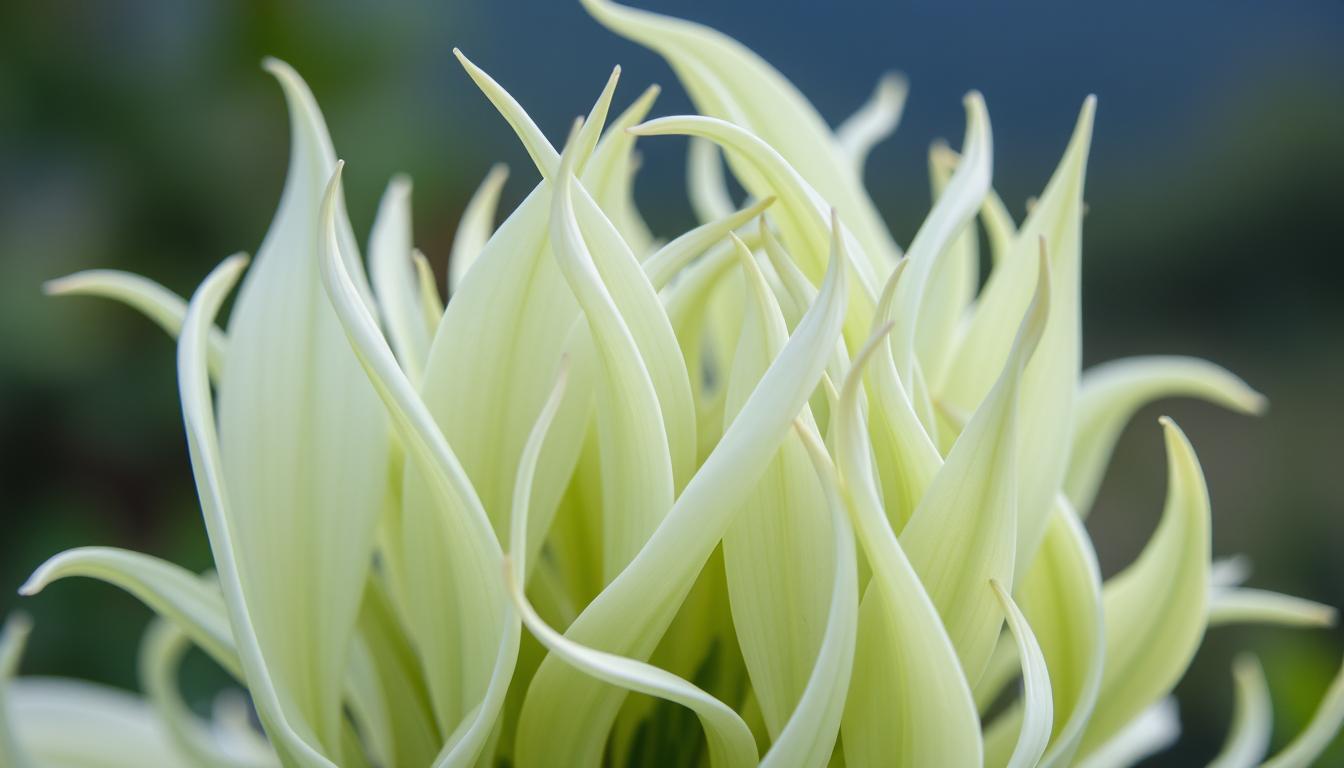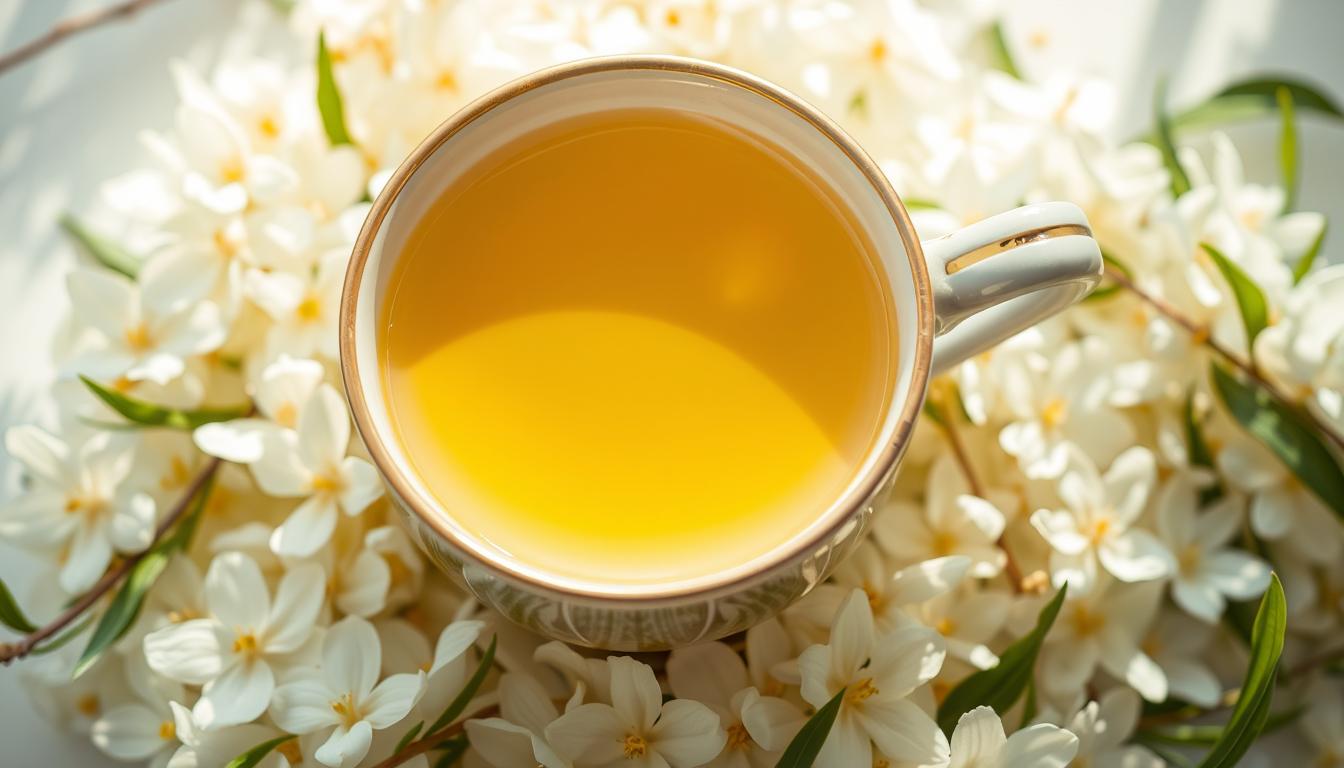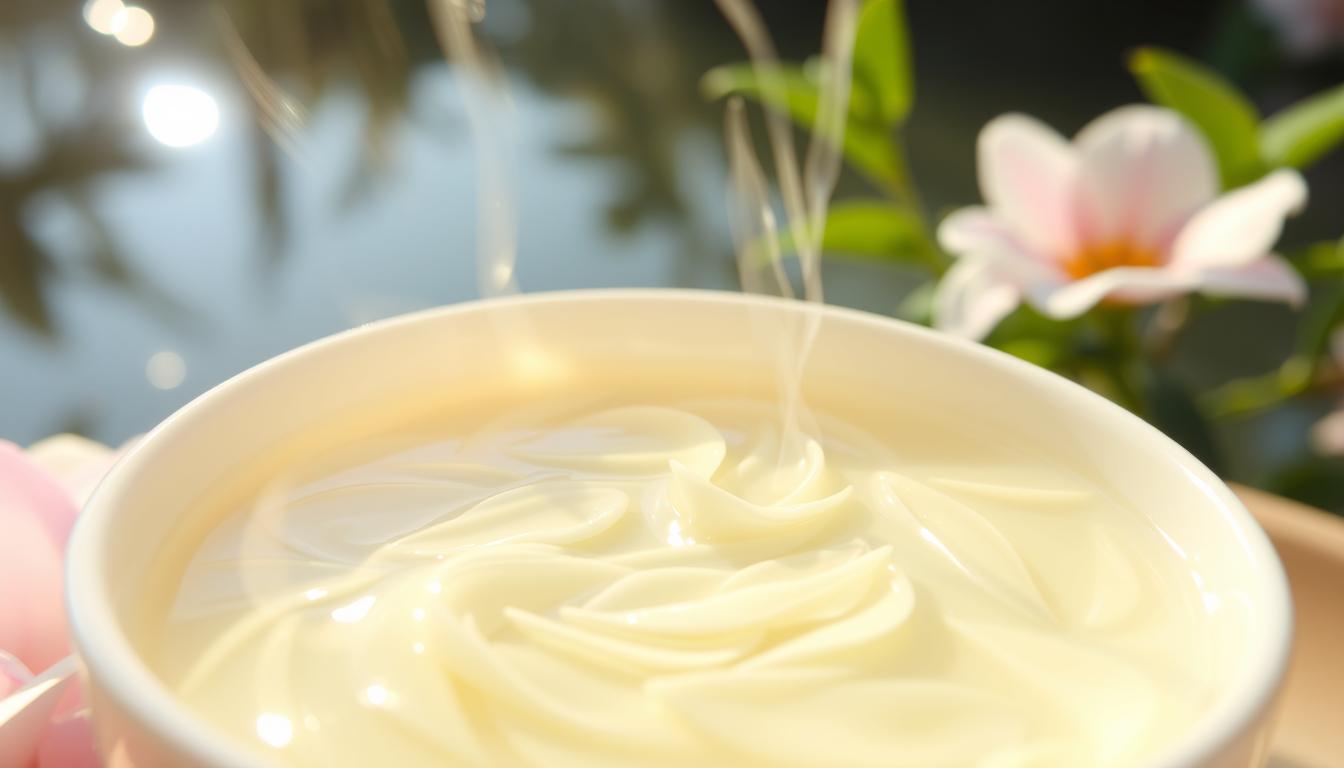White tea is loved for its light and unique flavors. It’s the most delicate tea because it’s processed very little. This makes its taste special.
Imagine drinking a tea that feels refreshing and gives you a unique taste. White tea does just that. It’s calming yet invigorating.
The taste of white tea is delicate because of how it’s handled. This careful process keeps its natural sweetness and subtle flavors. Whether you’re new to tea or a seasoned drinker, white tea’s taste will impress you.
Introduction to White Tea
White tea is a favorite for its light taste and unique flavors. In this article, we’ll explore its flavors, how to brew it, and what to pair with it.
Key Takeaways
- White tea is known for its delicate tea taste and unique white tea flavors.
- Its minimal processing helps preserve its natural sweetness and subtle flavor notes.
- White tea is considered the most delicate among teas due to its careful handling and processing.
- Its delicate flavor profile makes it a great choice for those looking for a soothing and invigorating tea experience.
- White tea flavors can vary depending on the type and quality of the tea leaves.
- Proper brewing and storage can help preserve the delicate flavor of white tea.
The Basics of White Tea: Understanding Its Unique Nature
White tea is known for its delicate flavor and lightness. This makes it different from other teas. The minimal processing helps keep its unique flavor and aroma.
When it comes to tea taste profiles, white tea is light and subtle. It has hints of sweetness and a delicate aroma. The types of white tea, like Silver Needle and White Peony, also shape its flavor. These types of white tea are known for their delicate flavor and light color.
Some of the key characteristics of white tea include:
- Delicate flavor and aroma
- Light color and minimal oxidation
- High antioxidant content
- Subtle sweetness and hints of fruit or floral notes

In comparison to other teas, white tea is more delicate and subtle. The minimal processing and careful handling preserve its natural flavor and aroma. This results in a unique and refreshing tea taste profile. Whether you’re a seasoned tea drinker or new to white tea, understanding its basics can enhance your appreciation of its delicate flavor and lightness.
Primary Flavor Notes of White Tea
White tea is known for its delicate taste. It has subtle flavor notes like floral, sweet, and fresh. These notes make white tea taste unique and refreshing.
The natural sweetness of white tea is a big part of its flavor. It adds a gentle sweetness without taking over. Floral notes, like rose and jasmine, balance out the sweetness. The fresh notes give white tea a light and airy feel, perfect for those who love a refreshing drink.
Common Flavor Profiles
Some common flavors in white tea include:
- Floral notes, such as rose and jasmine
- Sweet notes, such as honey and sugar
- Fresh notes, such as grass and citrus
The Hint of Vegetal and Grassy Notes
Some white teas also have hints of vegetal and grassy notes. These add depth and complexity to the tea’s flavor. These notes are often subtle and more noticeable in certain types, like Silver Needle or White Peony.

The primary flavor notes of white tea are key to its delicate taste. They come from natural sweetness, minimal processing, and floral, sweet, and fresh notes. Understanding these notes helps tea lovers appreciate white tea’s unique taste and enjoy its refreshing and soothing qualities.
Brewing White Tea: How It Affects the Taste
Several factors can change how white tea tastes. To enjoy its delicate flavors, you need to know how to brew it right. This includes the water’s temperature and the tea leaves’ quality.
Choosing the right tea leaves is the first step. Larger leaves make the tea taste more delicate. Optimal white tea brewing also means using water that’s not too hot. Water between 150°F and 160°F is best.
How long you steep the tea is also key. Steeping for 2-3 minutes is a good start. This lets the flavors come out without becoming bitter. With practice, you can bring out the best in white tea.
Key Considerations for White Tea Brewing
- Use high-quality tea leaves for the best flavor
- Optimize water temperature for delicate flavors
- Steep the tea for the right amount of time to avoid bitterness
Follow these tips and try different brewing methods. With a bit of effort, you’ll find the perfect way to enjoy white tea. Soon, you’ll appreciate its full range of flavors.
The Different Types of White Tea and Their Flavor Variations
White tea is known for its delicate flavor. It comes in various types, each with its own taste. From the sweet Silver Needle to the complex White Peony, each has its own charm. The types are based on the tea leaves, how they’re made, and where they come from.
Popular white teas include Silver Needle, White Peony, and Shou Mei. They are light and refreshing, with flavors of flowers, fruits, and honey. The taste of these teas changes based on the climate, soil, and altitude of the plants, as well as the making process.
Exploring the Flavor Profiles of Different White Teas
- Silver Needle: delicate, sweet, and floral
- White Peony: complex, fruity, and slightly sweet
- Shou Mei: light, refreshing, and hint of honey
There are many types of white tea for tea lovers to try. Whether you like a sweet tea or a fruity one, there’s something for you. Knowing about the different white teas and their flavors lets you enjoy each tea’s unique qualities.
| Type of White Tea | Flavor Profile | Region of Origin |
|---|---|---|
| Silver Needle | Delicate, sweet, and floral | China |
| White Peony | Complex, fruity, and slightly sweet | China |
| Shou Mei | Light, refreshing, and hint of honey | China |
How Growing Regions Affect the Flavor of White Tea
The flavor of white tea is greatly influenced by where it’s grown. Terroir, climate, and soil quality all matter. Terroir is especially key in white tea production.
White teas from different places taste different. This is because of the unique growing conditions. For example, Chinese white teas are known for their delicate taste. This is due to China’s mild weather and cool summers.
Several factors shape the flavor of white teas. These include:
- Soil quality: The soil where tea plants grow affects the tea’s taste.
- Climate: Weather conditions like temperature and sunlight impact tea flavor.
- Altitude: Tea grown at higher elevations often tastes more delicate and complex.
In summary, the growing region deeply influences white tea’s flavor. Terroir, climate, and soil quality all play a part. Understanding these factors helps tea lovers enjoy the diverse flavors of white tea from around the world.
| Region | Terroir | Climate | Flavor Profile |
|---|---|---|---|
| China | Unique combination of soil and climate | Mild winters and cool summers | Delicate and nuanced |
| India | Diverse range of soil types | Hot and humid | Strong and full-bodied |
| Japan | Volcanic soil | Temperate and humid | Light and refreshing |
The Lightness of White Tea: A Study of Its Subtlety
White tea is known for its light and smooth taste. This is due to its unique chemical makeup, especially the balance between astringency and sweetness. The minimal processing of white tea helps keep its natural sweetness.
The light taste of white tea comes from a balance of astringency and sweetness. Astringency is a dry feeling in the mouth, while sweetness is a sugary taste. This balance makes white tea smooth and refreshing.
What Makes White Tea Feel Light and Smooth
Several things make white tea taste light and smooth. These include:
- The low level of tannins, which are compounds that can give tea a bitter taste
- The high level of antioxidants, which help to balance out the flavor and provide a smooth mouthfeel
- The minimal processing of white tea, which helps to preserve the natural sweetness and delicate flavor of the tea leaves
The Balance Between Astringency and Sweetness
The balance between astringency and sweetness is key in white tea. It determines the overall flavor. A good balance makes the tea taste refreshing and smooth. This balance comes from carefully selecting tea leaves and the minimal processing of white tea.
Freshness and Storage: Preserving the Taste of White Tea
White tea flavors are delicate and can be easily lost if not stored properly. Freshness is key to keeping the taste of white tea. If not stored right, it can quickly become stale and lose its unique flavor.
To keep white tea flavors at their best, it’s important to store it in a cool, dry place. It should be away from direct sunlight and moisture. Here are some tips for storing white tea:
- Store white tea in an airtight container to prevent air and moisture from entering.
- Keep the container away from strong-smelling foods, as white tea can absorb odors easily.
- Avoid storing white tea in the refrigerator or freezer, as the humidity can cause the tea to become stale.
By following these storage tips, you can help preserve the delicate white tea flavors. This way, you can enjoy your tea at its best.
Remember, the key to preserving white tea flavors is to store it properly and keep it fresh. With proper storage, you can enjoy the unique and delicate taste of white tea for a longer period.
Pairing White Tea: The Best Foods and Flavors to Complement Its Taste
Pairing white tea with food aims to enhance its delicate taste without overpowering it. White tea flavors are subtle and refined. They pair well with light snacks and desserts. Try pairing it with fresh fruits, nuts, or delicate pastries to bring out its flavor.
The goal is to balance the flavors of the food with the tea. For instance, a sweet dessert can be balanced by white tea’s delicate taste. This creates a refreshing and harmonious combination. Here are some great flavor combinations:
- Fresh fruits, like strawberries or grapes, complement white tea’s sweet and floral notes.
- Delicate pastries, such as petit fours or macarons, pair well with white tea’s subtle flavor.
- Nuts, like almonds or pistachios, add a satisfying crunch to the pairing.
Pairing white tea with the right foods can enhance its flavor. Whether you like sweet treats or savory snacks, there’s a perfect match for white tea’s subtle taste.
Exploring white tea pairings can be fun. Try different combinations to find your favorite. White tea’s delicate taste makes it great for elevating your tea experience and discovering new flavors.
| Food | White Tea Flavor | Pairing Notes |
|---|---|---|
| Fresh Fruits | Sweet and Floral | Complementary flavors create a harmonious combination |
| Delicate Pastries | Subtle and Refined | Pairing enhances the delicate flavor of white tea |
| Nuts | Crunchy and Savory | Contrasting textures add depth to the pairing |
Is White Tea Sweet? Exploring the Sweetness in White Tea
White tea is known for its light and refreshing taste. Its natural sweetness comes from the processing stage. The sweetness level can change based on the tea leaves, growing conditions, and how it’s processed.
The minimal processing of white tea helps keep its natural sweetness. Unlike other teas, white tea isn’t fermented. This means its flavors and aromas are preserved. The result is a tea that’s both refreshing and soothing.
Factors Affecting Sweetness
Several things can change how sweet white tea is. The type of tea leaves, climate, and soil all play a role. For example, white teas grown in cooler climates are often sweeter. The quality of the leaves and how they’re processed also matter.
Variations in Sweetness
Some white teas are sweeter than others. This is because of the tea cultivar, growing conditions, and processing. For instance, Silver Needle white tea is sweet and delicate. White Peony is light and refreshing. Knowing what affects sweetness helps tea lovers enjoy each white tea’s unique taste.
Conclusion: Appreciating the Delicate Flavor of White Tea
White tea offers a unique experience of subtle sophistication. Its delicate flavor makes it special, inviting us to enjoy the fine notes in each sip.
The lightness and natural sweetness of white tea are captivating. Understanding its taste, from processing to growing regions, shows the care in every cup. Exploring different white teas, like Silver Needle and White Peony, is a rewarding journey.
Why White Tea’s Subtle Taste is Worth Savoring
White tea is a refreshing change from bold flavors. Its delicate taste encourages mindfulness, letting us fully enjoy the experience. By slowing down, we discover a world of flavors that enhance our tea time.
How to Make the Most of Your White Tea Experience
To enjoy white tea’s delicate taste, focus on brewing, water temperature, and steeping time. Try different teas to find your favorite. Pair it with light foods to complement its subtle flavors. Most importantly, slow down and let the tea’s complexity shine.

